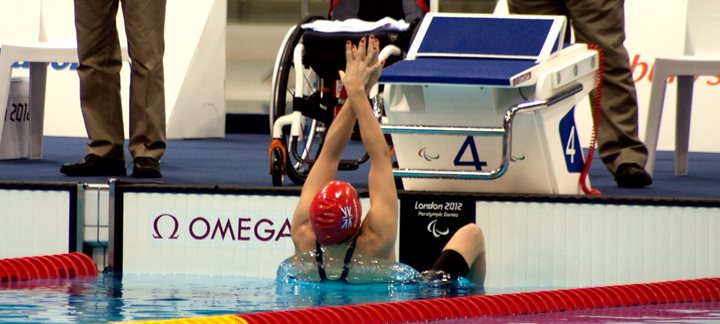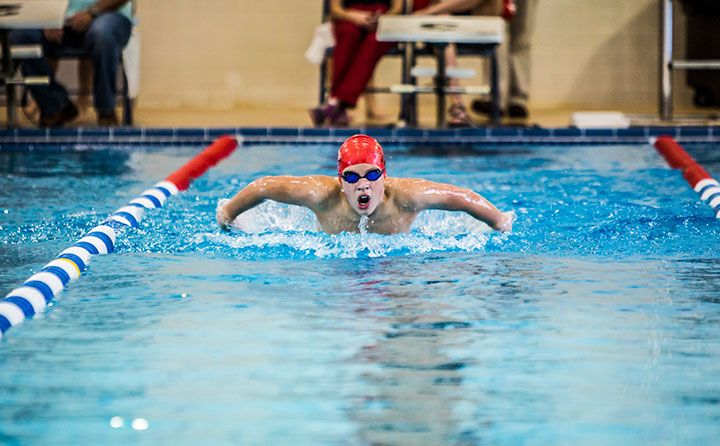Share:
Take it offline!
This Education in Motion resource is also available as a printable PDF.
Download PDF
Adapted swimming is a versatile sport which boasts a variety of therapeutic benefits for people with disabilities. With a few small changes, pools can be made accessible to allow swimmers from all walks of life to take part in an all-body workout with little to no strain, impact, or pain.
Why Swimming?
Swimming is a low-impact exercise which promotes basic physical abilities, fitness, injury rehabilitation, and mental well-being. Swimming is an inclusive activity where athletes with disabilities can take part for leisure or competition. Due to the communal nature of public pools, it can also provide an avenue of social interaction and building community.
When in the water, swimmers are able to engage the joints of their body without straining them, and with a smaller risk of injury than most other fitness activities. Many people with disabilities also report that their chronic pain lessens while in the water due to the weightlessness that they experience.
In her 2013 article, Swimming: the Perfect Disabled Workout, author Hope Whitmore reports finding great relief from her physical pain through swimming. She writes, “swimming returned a freeness which I thought I had lost… and I was quickly away, swimming lengths as freely as I had once run.”

Accessible Swimming Pools
Most pools are already accessible, but a few key adaptations can be implemented to make them more inclusive and safe.
Here are just a few ways in which swimmers with disabilities can be better accommodated in the water:
- A pool may feature a zero depth entry point, a hoist, a platform lift, or a ramp to assist swimmers when entering the water.
- Brightly colored lane markers can help people with visual impairments to identify the boundary around lanes.
- Adapted pools can have textured edges, walls, and floors to assist visually impaired swimmers in safely measuring distance and executing turns.
- Sometimes, a trained member of staff, or a guide, may be stationed at the end of the pool to tap swimmers when they need to turn.
- In competitive swimming, athletes may start from three different positions to suit their abilities: standing, sitting, or within the water.
Competitive Adapted Swimming
In adapted swimming events like the Paralympics, athletes are categorised by the extent to which their disability impacts their performance in the water. The classes S1 through to S10 represent people with physical disabilities, where athletes in the S1 class find their performance is more heavily affected while swimming than those in S10.
"S" shows that the competition is freestyle, backstroke, or butterfly, "SB" represents breaststroke, and “SM” indicates that the event is a medley. The classes S11, S12, and S13 are reserved for those who are blind or visually impaired, and S14 is for athletes with intellectual disabilities.
In breaststroke events, some swimmers compete in a lower class than they would for other swimming styles because the stroke requires more leg propulsion, and so their disability has a greater impact on their performance.

Accomplished Adapted Swimmers
Matthew Cowdrey has achieved a recording-breaking career after competing for Australia 3 times in the Paralympics. He enters retirement as the most successful Australian Paralympian in history with a total of 23 Paralympic medals including 13 gold. Matthew was born without his lower left arm but he hasn’t let that stop him from breaking world records and still holds 14 currently. After competing in the 2004, 2008, 2012 Paralympics and three World championships he has paved the way for adapted swimming. Although Matthew retired from competitive swimming in 2015, he has achieved outside of the water receiving an Order of Australia medal, Australian Paralympian and Young South Australian of the Year.
Blake Cochrane overcame multiple congenital deficiencies affecting his hands and feet. His parents had enrolled him in swimming to reduce his asthma but his natural talent for swimming was soon discovered. He competed for Australia in 3 Paralympics where he competed in SB7 100m breaststroke and S8 100m backstroke. He also set a new world record in the 100m breaststroke final in the 2011 Pan Pacific Para-Swimming Championship.
Adapted swimming is a wonderful way for people with disabilities to work gentle exercise back into their routines. Due to its low-impact nature, swimming mitigates much of the risk, pain, and strain presented by more conventional sports, and can strengthen swimmers’ mental and physical well-being.